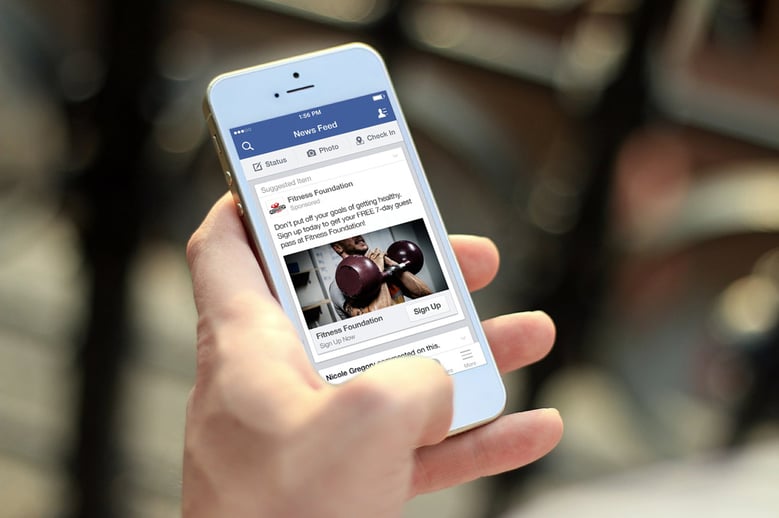
As a fitness business, you're always looking for ways to grow your membership base. Compelling promotions and strategic marketing pushes to your current audience are a great place to start, but marketing to the same list of email addresses again and again can get stale and ineffective rather quickly. So how can you get your business in front of a new, yet still targeted, audience?
Paid online advertising.
Running ads doesn’t have to cost you a lot of time or money. Sometimes simply spreading $5 a day across a few ad platforms is enough to generate new leads for your business. Let's take a look at some of the best practices you should be following for your paid advertising campaigns.
What Should Your Paid Ads Accomplish?
Before creating an ad, you should define your goal. Think about what you want to accomplish with your ad. Do you want to grow your member base? That’s great, but different ad campaigns will yield different results depending on the time of year, what you’re promoting, how much money you want to spend, and so on, which means you need to be more specific with your goals.
For example, let's say you want to run an ad during the post-New Year’s rush. Your initial goal might look something like this:
“I want to create a Google AdWords ad to grow my memberships during the post-New Year’s rush.”
While that’s an appropriate goal statement, it doesn’t really take into account the potential buyer's journey of anyone that clicks on your ad. The buyer's journey is the steps a person takes to go from stranger to paying member. Just because you want to increase memberships doesn’t mean the person will become a member after seeing a single ad. You either have to be slower with your sales pitch or give your audience a reason to take action faster than they normally would. That’s where a great intro offer or limited-time promotion can come in handy.
A proven intro offer or promotion can inspire leads to close themselves. To do this, you want to invoke a sense of urgency in your prospects. Make sure they know the offer is limited and just for them, which is true since your ad campaigns will indeed be targeted to people just like them.
What Type of Paid Ads Should You Run?
Each ad platform offers its own types of ads. There are even different types of ads within ads, such as a Google AdWords text-only ad that focuses solely on trying to get people to call you on the telephone. Then there are Facebook video ads, which can be a great way to give a visual overview of your business, what you offer, and, most importantly, how you can benefit a prospect’s life. Then there’s Twitter, Pinterest, LinkedIn, Foursquare, Instagram, Snapchat, Waze, and even more ad platforms you can try.
The point is to try some ads on the platforms most relevant to your buyer personas (i.e. if your typical buyer persona is 40+ years old, you don’t need to waste money on Snapchat ads) and see what works. Then, do more of what works and less of what doesn’t. While this sounds simple enough, don't forget to keep an eye on your campaigns, remember your goals, focus on targeting, and don’t go over your budget.
What Should Your Paid Ads Say?
Your ad copy, images, and other elements should be related to what you’re promoting. Almost all of the various ad platforms are going to be grading your ads behind the scenes. These grades are typically referred to as quality scores. A high quality score is how your ads can compete with bigger companies that are spending a lot more on ads. If your ad has a higher quality score even with a lower ad bid, you may still show above a company that's spending more money.
A great way to get a high quality score is to keep everything relevant. For instance, if your ad talks about your new stationary bikes, the URL your ad sends people to should mention stationary bikes (ex. www.yourwebsite.com/stationary-bikes) and the page itself should talk about stationary bikes.
Even though you’re paying for ads, each ad platform is going to keep an eye on your ad activity and monitor for quality. They want to make sure you’re not upsetting their users with bait and switches, overly sales-y copy, irrelevant images, and similar dubious tactics.
A Note On the Importance of Paid Ad Localization
As you're creating your paid ad campaigns, it's critical to ensure your ads are only targeting people in areas geographically relevant to your business. This means you should not be running nationwide ads, as you’ll blow through your ad budget very quickly.
Instead, you should always look for each ad platforms’ geographic targeting options. These options will allow you to focus on specific zip codes or cities where people live close enough to your business that they’d actually become a member of your gym.

Just be careful not to make your area too small as you may not have a large enough pool of people to see your ad, thus making it fail before it even runs.
How Do You Know If Your Paid Ads Are Working?
Paid ads require a bit of patience. You need to give them enough time to succeed or fail. If you stop them too soon, you may not have given them enough time to prove themselves. Try to give your ads at least a month to produce results.
However, once you know what you’re looking for in a successful ad, you'll be able to spot any issues much faster and won't have to run them for as long to know if they're working. This doesn’t mean you have to let the ad run unchanged for a month, it just means you should give each ad platform enough time to prove itself.
Ideally, with ads, you want to spend less money and see better results. Here are a few of the many factors that can contribute to an ad's success or failure:
- Max Spend—how much you’re willing to spend per day or per campaign.
- Bid—how much you’re willing to spend per click/tap.
- Quality Score:—how the ad platform views your ad and whether it deems it valuable enough to display instead of other ads competing for the same spot.
- Localized Targeting—ads are in front of people in your geographical area and display messages that appeal to them directly.
- Offer—what you use to entice someone to click or tap your ads.
- Copy & creatives—what your ad says and the visual elements it contains such as video, image, etc.
- Ad Platform—the platform you're using and how relevant it is to your ideal customer profiles.
Pro Tip: A CRM system like Club OS can help you gauge whether or not your paid ads are working by capturing leads that come from paid advertising and dropping them directly into your sales funnel. With this type of integration, it's easy to see whether your ads are paying off.
Give Paid Ads a Try with the Help of Club OS
Are you ready to give paid ads a try but wish you had a little more help? Club OS's fitness advertising ebook, A How-To Advertising Guide for Gyms and Fitness Businesses, takes you step-by-step through the ad creation process for Facebook, Twitter, and Google AdWords.
Download our free guide today and start achieving your paid ad goals!
-1.png?width=419&name=adversiting-ebook-mockup%20(1)-1.png)